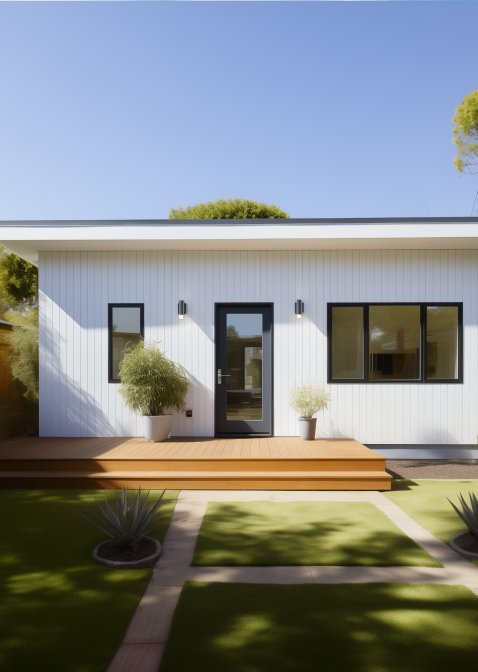People have been building houses since the dawn of time. And the question of materials has always been under heated discussion. Nowadays on the market one can find tremendous numbers of novelties concerning the materials. However, one of such options stands out from others. In this article we will discuss Structural Insulated Panels, or SIPs. Continue reading this text to find out more about them.
Structural Insulated Panels (SIPs) are a recent trend in the world of construction materials. Under close examination one can notice that it is simply a layer of insulation put in-between two layers of oriented strand board (OSB). In addition to their energy-saving properties, SIPs are also highly sound-insulating and fire-resistant, which makes them a safe and reliable choice for any building project.
With their easy installation, cost-effectiveness, and environmental benefits, SIPs are a smart choice for modern construction practices.
As you may have already understood, SIPs possess a variety of advantages. Let us take a closer look at some of them.
With superior thermal insulation, SIPs can help reduce energy costs while creating a comfortable living environment. In fact, a study by the University of Colorado found that SIPs can reduce energy consumption by up to 60% in comparison to the normal construction. Moreover, the insulation can help reduce outside noise levels by up to 50%, creating a peaceful and relaxing living space.
The insulation layer sandwiched between the two layers of structural board provides additional support, making SIPs ideal for areas prone to harsh weather conditions. For instance, a home constructed with SIPs can withstand winds of up to 140 miles per hour, making them an excellent option for homes in hurricane-prone regions. Moreover, SIPs can accommodate more extensive spans, enabling builders to create larger, more open living spaces.
Prefabricated SIPs can significantly reduce construction time and labor costs. With their quick assembly design, a 2,000 square foot home can be constructed with SIPs in as little as two weeks. It will be hard for the workers to make any mistakes as all panels fit together seamlessly. This leads to faster completion times, allowing homeowners to move into their new homes more quickly. With their innovative and time-saving features, SIPs offer an exceptional option for anyone looking to build a home or structure efficiently without sacrificing quality or durability.
While SIPs may require a higher upfront investment, the energy savings and faster construction time can offset this cost, making SIPs a more affordable option over the long-term. In fact, a study by the National Institute of Standards and Technology found that SIPs can save up to 40% on heating and cooling costs compared to traditional stick-built construction. Additionally, SIPs require less maintenance than traditional materials, leading to further cost savings over time. With their ability to provide long-term cost savings, energy efficiency, and durability, SIPs are a wise and practical investment for any construction project.
By using less energy and generating less waste, SIPs are an environmentally responsible choice compared to traditional building materials. Moreover, SIPs can be recycled at the end of their lifespan, significantly reducing the environmental impact of construction waste. With their versatile design, SIPs can also be used to create buildings that are tailored to fit into nearly any environment or climate, making them a sustainable option for a wide range of projects. For example, SIPs have been used to construct net-zero energy homes that generate as much energy as they consume, providing an innovative and sustainable solution for environmentally conscious homeowners.
With their highly customizable design, SIPs offer builders the freedom to create unique and innovative structures that meet their specific needs. Moreover, SIPs can be used with a wide range of architectural styles, from traditional to modern, making them a flexible and practical choice for any project. For instance, SIPs have been utilized to construct a diverse range of buildings, from schools and offices to multi-family homes and custom-built single-family homes, highlighting their versatility and adaptability. With their exceptional design flexibility, SIPs offer endless possibilities for builders and architects looking to create extraordinary and sustainable structures.
While there are many advantages to using Structural Insulated Panels (SIPs) in construction, there are also some potential drawbacks that should be considered.
The disadvantages include:
It’s important to weigh these potential drawbacks against the advantages of SIPs when considering their use in a construction project. Working with experienced professionals and ensuring proper design and installation can help mitigate these concerns and ensure a successful outcome.
It’s almost impossible to enumerate all options where Structural Insulated Panels (SIPs) can come in handy. However, we have prepared a list where you can find the most common options where SIPs can be used.
SIPs are commonly used for:
Overall, SIPs can be used in a wide range of construction projects, providing superior insulation, structural strength, and energy efficiency compared to traditional building materials.
All in all, SIPs are a promising technology in the building industry that offer many benefits for builders and homeowners alike. By understanding their advantages and limitations, with help from experienced professionals, SIPs can be a smart choice for creating buildings of your dream.
However, as with any construction material, SIPs do have potential drawbacks, such as higher upfront costs, limited availability and contractor experience, and moisture and air infiltration concerns. It’s important to weigh these potential issues against the benefits of SIPs when considering their use in a construction project.











